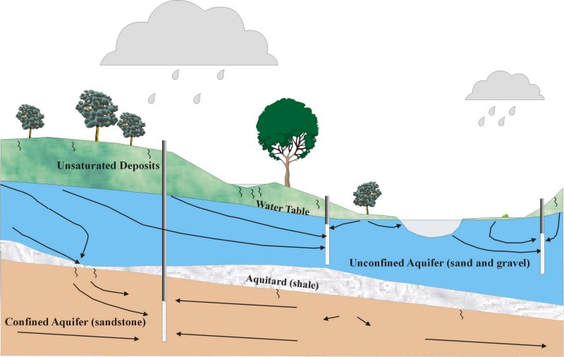 The people of Wisconsin are concerned about what’s happening to their water. This concern was shown Monday night in Stevens Point, where more than 90 people packed the Pinery Room at the Portage County Library to hear Dr. George Kraft talk about the science and policy debate around high capacity wells – read more about this event here. Dr. Kraft’s presentation was captured in an informal video on Facebook live, visit the LWV UMRR Facebook page and look under”Videos”.  Dr. Kraft is Professor Emeritus from the University of Wisconsin Stevens Point. His work has focused on groundwater resource sustainability, particularly about profitable agriculture and water impacts, and is involved in work to modernize Wisconsin’s groundwater pumping management policy and laws. Wisconsin’s Central Sands region is where Dr. Kraft has spent much of his career, and was the focus of his remarks Monday night. In his talk, Dr. Kraft first talked about groundwater hydrology; explaining the connection between ground- and surface waters. When groundwater levels drop, whether from lack of recharge in dry times or from pumping from wells, surface water resources are also affected. (If the water table drops eight feet, for example, spring-fed streams that intersect the water table will also go down to the same elevation as the water table. The actual amount of drop in surface water levels depends on their normal water level elevation.) Shallower streams like minor tributaries are often dried up, and deeper water bodies will drop in water level. When the amount of cold groundwater entering a stream diminishes, the water warms. Warmer streams longer support trout and other cold-water species, meaning that groundwater depletion leads to ecological change as well.  Dr. Kraft's slide showing the drop in groundwater levels in the Central Sands. The red area has the greatest drop - more than 30'. Dr. Kraft's slide showing the drop in groundwater levels in the Central Sands. The red area has the greatest drop - more than 30'. Dr. Kraft talked about the continued expansion of farm irrigation in Wisconsin’s Central Sands. The number of high-capacity irrigation wells in this area has grown significantly, and resultant drops in the water table level have been recorded. What is the effect of this? Dr. Kraft showed pictures of lakes and streams where water levels have dropped, which is especially dramatic in dry years. This isn’t just happening in Wisconsin – Minnesota has similar geologic terrains and similar problems. Dr. Kraft talked about the approach that the Minnesota Department of Natural Resources is taking in the Straight River Groundwater Management Area- read about that here. A second project in Minnesota relating to water use and depletion was reported on in this blog earlier – the Little Rock Creek study. So, will the irrigation wells run out of water, too? Dr. Kraft said that there’s probably plenty of water for irrigation wells for years to come. Central Wisconsin is a water-rich area, receiving more than 30 inches of rain a year. Groundwater is recharged by the rain, and the aquifers here are deep. The groundwater resource will sustain heavy pumping for the foreseeable future, but the impacts on surface water will continue. It is up to the people of Wisconsin to balance theses competing values.  While Dr. Kraft’s talk focused on water quantity, water quality is also an issue in central Wisconsin. Both are addressed by the Center for Watershed Science and Management at the University of Wisconsin Stevens Point. Dr. Paul McGinley is the Director of this Center, Dr. Kraft is an emeritus member and Kevin Masarik, a doctoral student at UW Madison, is also part of the team. Another hydrologist will soon be hired to round out the team. Support for the Center’s staff comes primarily from UW Extension, so outreach to citizens, lake associations and others is a major part of their work. Nitrate contamination is a real problem in Wisconsin, affecting more than 25% of all private wells. Here’s a video presentation where Kevin Masarik explains what nitrate is and explores the effects of nitrate on the environment, drinking water and groundwater. In this video, Masarik discusses data found in Wisconsin’s Well Water Viewer, which can be found at this link. Wisconsin’s groundwater has been the subject of other posts on this blog. See “Protecting Wisconsin Well Owners and Providing Safe Water” at https://www.lwvumrr.org/blog/protecting-wisconsin-well-owners-and-providing-safe-water and “When it Hits the Fan – Groundwater Quality and Public Health” at https://www.lwvumrr.org/blog/when-it-hits-the-fan-groundwater-quality-and-public-health .
0 Comments
Leave a Reply. |
| LWV Upper Mississippi River Region | UMRR blog |

 RSS Feed
RSS Feed